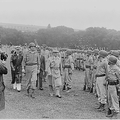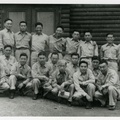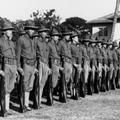Washington, DC. “What are those two goddam Japs doing here? Shoot ‘em.”
Someone said, “No, they’re good Japs, working for us. Well, shoot ‘em anyway.”
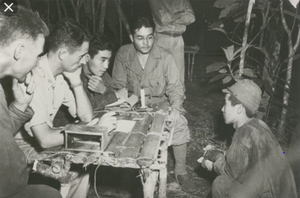
The conversation occurred in 1942 in Guadalcanal, Solomon Islands, at XIV Corps, as Military Intelligence Service (MIS) linguists Shigeru Yamashita and Isao Kusuda walked by; American commanders as well as soldiers questioned the loyalty of Nisei and did not want them around. A major task of Caucasian MIS Team Leaders, with varying Japanese language skills, was to change this anti-Nisei bias. They also authenticated the Nisei, validated the accuracy of their translation or interrogation reports, and supported the Nisei in their interactions with doubtful Caucasian staff and commanders. MIS Nisei linguists in Asia Pacific Theater had three missions: help win the war, fight discrimination on the home front, and fight discrimination overseas.
From this challenging beginning, Nisei linguists diligently passed to combat commanders tactical intelligence obtained from captured documents and prisoners. Caucasian officers and soldiers changed their attitude when they began experiencing how timely tactical intelligence from documents and prisoners won battles and saved lives. When Japanese families began returning to their homes on the Pacific coast to racially-charged receptions, Caucasian soldiers who served overseas with Nisei, challenged the bigotry by vouching for Nisei loyalty and patriotism thereby accelerating their integration in America’s mainstream. The highest praise for the Nisei linguists' loyalty and indispensable skills came from President Harry Truman when he referred to them as “our human secret weapon.”
US military Japan Specialists in the War Department soon realized that intelligence officers with one or two years of language training were unlikely to reach the level of fluency needed to translate all handwritten Japanese documents. They came to understand that native fluency could only be achieved by long residence in a Japanese environment and by attending Japanese schools. They recognized that for ideal intelligence officer candidates, the higher the level of education and the longer the stay in Japan, the greater the knowledge of the language as well as ties to Japan. This group, which the Japanese called Kibei (born in US, studied in Japan, returned to US), who had regained their fluency in English, ranked high for US Army recruitment. Although some viewed such recruits with concern, there was no case of a Nisei violating his oath of enlistment. Meanwhile the Japanese military had incorrectly assumed Nisei were not being used in the Pacific War and took comfort that no Caucasian had the ability to read their written language.
The first class of 42 Japanese language trainees at the MIS Language School (MISLS), which included two Caucasians - 1st Lt John Alfred Burden and 1st Lt David E. Swift Jr., began in Fall 1941, just prior to the Pearl Harbor attack. Nisei volunteered to serve in the first, second and third wave of Marine and infantry invasions to translate documents, interrogate prisoners and pass reports immediately to commanders to prepare counter actions. They also entered caves to persuade Japanese soldiers to surrender. While the risk of getting killed was high, many Nisei felt they could do the most good in those positions. General George C. Marshall, who assumed Nisei served at the Division and Corps headquarters, was surprised to hear of their use on the front lines.

Eventually, some 6,000 Nisei linguists graduated from MISLS and were assigned in small teams to every unit that required them during and after WWII. They also served with Allied forces of Australia and Great Britain. When the war ended, Nisei served in the demobilization and occupation of Japan as well the war crimes trials - efforts that insured a peaceful transition from wartime to peacetime Japan.
Burden and other Caucasian team leaders elevated the value and recognition of Nisei linguists in the Asia Pacific Theater. Nisei linguists’ superior performance on and off the battlefield caused infantry and marine commanders to recommend them for combat awards, promotion to officer rank and for language team leader positions. MISers reciprocated by staying in the service and using their language skills for post war duties in Japan.
1st Lt (Colonel when he retired) Burden attended school in Japan, obtained a medical degree in Kentucky, and served as a sugar plantation doctor in Maui, Hawaii. When the first MISLS class was formed, his Army reserve officer status was activated and ordered to attend the first MISLS class. Upon graduation he was sent as a MIS team leader to Fiji, where he was assigned to monitor incoming telephone calls, a duty that did not utilize his language training and knowledge of Japan. Japanese American MISLS graduates were also wrongly assigned. For instance, MISLS graduate Masanori Minamoto,was sent to Tonga where he was assigned as a truck driver, while MISLS graduate Tateshi Miyasaki,was assigned to be a General’s jeep driver. During Admiral Chester W. Nimitz, Commander-in-Chief of Pacific Fleet, visit to Fiji he was introduced to Burden. Once he learned of Burden's language skills, Nimitiz told Burden to pack his bags, and take a flight to Guadalcanal.
When Burden reported to MG Alexander M. Patch, CG of XIV Corps, Patch said he saw no value in the assignment of Japanese linguists. He wanted “all Japs killed.” Such a mindset was, all to often, shared by infantry and marine officers and enlisted ranks. Meanwhile, Patch was sending documents to his rear headquarters in Noumea, New Caledonia with a turnaround translation time of six weeks. Burden convinced Patch and subordinate officers about the value of on-the-spot translations and interrogations, in addition to the preparation of air drop of leaflets to persuade the Japanese to surrender. Burden worked to have Minamoto and Miyasaki assigned to Guadalcanal and they began producing and circulating their reports that convinced American commanders the value of taking prisoners.
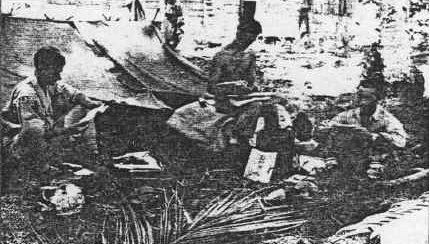
1st Lt (Lt Col when he retired) Swift, also a Caucasian graduate of MISLS first class, was also born in Japan, the son of a professor at the Tokyo Imperial University. Born in 1896, he left Japan in 1913 to attend school in the US. He enlisted in the US Navy and served during WWI. Swift then joined the US Immigration Service and later transferred to US Customs Service. He received a reserve commission in 1933 while serving as a customs officer. Swift led a team of eight graduates of the first MISLS class to Brisbane, Australia, where he helped activate and run the Allied Translation and Interpreter Service (ATIS). Retiring from the Army reserve in 1946, Swift returned to his US Customs job.
Lt Benjamin H. Hazard, Jr., who was commissioned after studying Japanese at University of Michigan and MISLS, was assigned to Saipan toward the end of that campaign. He was the unit leader when Hoichi Kubo entered a cave and convinced eight armed Japanese soldiers to release their 120 civilian hostages. Knowing a high award for valor required eye witness affidavits from Americans and knowing Kubo was the only American in the cave, Hazard obtained affidavits from a few Japanese civilians of Kubo’s actions in the cave. Hazard used these Japanese affidavits for the recommendation for Distinguished Service Cross (DSC), the second highest military award and highest battlefield award given to an MISer.
William A. Laffin was born in Japan of an American father and a Japanese mother. He served with the Merrill’s Marauders in Burma as an MIS team leader. After leading a patrol of Burmese Kachin soldiers to reconnoiter a route in the jungle, he did the same by aircraft. His plane was shot down by Japanese forces and he perished. Other Caucasian team leaders included Richard Kleeman and Horace Feldman, both late members of JAVA, Lawrence P. Dowd, and William L. Dozier.
JAVA Member Dr. James McNaughton, the US Government’s authority on the MIS, summed up the Nisei and Caucasian officers roles in MIS this way: “During the American occupation of Japan [the MIS] helped turn bitter enemies into friends thus securing the victory and serving as a bridge between the two cultures. Caucasian team leaders forged strong bonds with the Nisei linguists in the crucible of combat, even though their language proficiency was often much less. They quickly saw how the Nisei provided valuable intelligence on every battlefield and became their strongest advocates.”
JAVA offers its thanks to the Caucasian team leaders for facilitating the Nisei linguists success.
[JAVA Editer's Note: JAVA Research Team appreciates the research support to this article provided by Mark Matsunaga, Historian of MIS Veterans Hawaii.]
* This article was originally published in Japanese American Veterans Association e-Advocate on October 16, 2019.
© 2019 Japanese American Veterans Association


